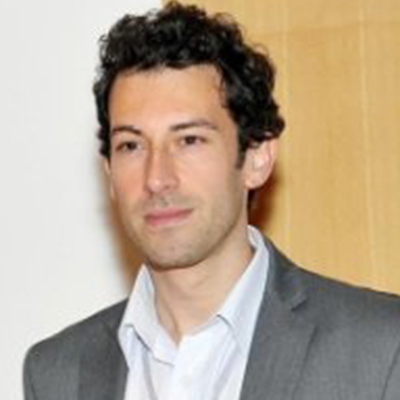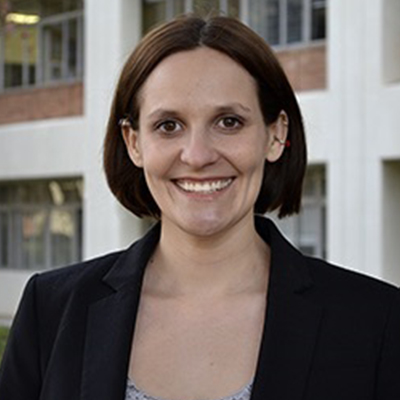Biography
Dr. Sagasti received his PhD from UCSF, where he worked with Cori Bargmann studying celll specification and left/right asymmetry in the nervous system of the nematode C. elegans. He began using zebrafish as a model at the Skirball Institute, NYU Medical Center as a post-doc with Alex Schier. In the summer of 2005 he was a Grass Foundation Fellow at the Marine Biological Labs in Woods Hole, Massachussetts. He began as a UCLA faculty member in the MCDB department in September 2005. His lab uses a combination of imaging, molecular, and genetic approaches in zebrafish to investigate on the morphogenesis of sensory axons and skin cells during development and repair.
Publications
A selected list of publications:
Vargas Mauricio Enrique, Yamagishi Yuya, Tessier-Lavigne Marc, Sagasti Alvaro Live Imaging of Calcium Dynamics during Axon Degeneration Reveals Two Functionally Distinct Phases of Calcium Influx The Journal of neuroscience : the official journal of the Society for Neuroscience, 2015; 35(45): 15026-38.
Rasmussen Jeffrey P, Sack Georgeann S, Martin Seanna M, Sagasti Alvaro Vertebrate epidermal cells are broad-specificity phagocytes that clear sensory axon debris The Journal of neuroscience : the official journal of the Society for Neuroscience, 2015; 35(2): 559-70.
O’Donnell Kelley C, Lulla Aaron, Stahl Mark C, Wheat Nickolas D, Bronstein Jeff M, Sagasti Alvaro Axon degeneration and PGC-1α-mediated protection in a zebrafish model of α-synuclein toxicity Disease models & mechanisms, 2014; 7(5): 571-82.
O’Donnell Kelley C, Vargas Mauricio E, Sagasti Alvaro WldS and PGC-1α regulate mitochondrial transport and oxidation state after axonal injury The Journal of neuroscience : the official journal of the Society for Neuroscience, 2013; 33(37): 14778-90.
Palanca Ana Marie S, Lee Sung-Ling, Yee Laura E, Joe-Wong Carlee, Trinh Le A, Hiroyasu Elizabeth, Husain Majid, Fraser Scott E, Pellegrini Matteo, Sagasti Alvaro New transgenic reporters identify somatosensory neuron subtypes in larval zebrafish Developmental neurobiology, 2013; 73(2): 152-67.
Villegas Rosario, Martin Seanna M, O’Donnell Kelley C, Carrillo Simon A, Sagasti Alvaro, Allende Miguel L Dynamics of degeneration and regeneration in developing zebrafish peripheral axons reveals a requirement for extrinsic cell types Neural development, 2012; 7(6): 19.
O’Brien Georgeann S, Rieger Sandra, Wang Fang, Smolen Gromoslaw A, Gonzalez Robert E, Buchanan JoAnn, Sagasti Alvaro Coordinate development of skin cells and cutaneous sensory axons in zebrafish The Journal of comparative neurology, 2012; 520(4): 816-31.
Wang Fang, Wolfson Sean N, Gharib Arash, Sagasti Alvaro LAR receptor tyrosine phosphatases and HSPGs guide peripheral sensory axons to the skin Current biology : CB, 2012; 22(5): 373-82.
Rieger Sandra, Sagasti Alvaro Hydrogen peroxide promotes injury-induced peripheral sensory axon regeneration in the zebrafish skin PLoS biology, 2011; 9(5): e1000621.
Martin Seanna M, O’Brien Georgeann S, Portera-Cailliau Carlos, Sagasti Alvaro Wallerian degeneration of zebrafish trigeminal axons in the skin is required for regeneration and developmental pruning Development (Cambridge, England), 2010; 137(23): 3985-94.
O’Brien Georgeann S, Martin Seanna M, Söllner Christian, Wright Gavin J, Becker Catherina G, Portera-Cailliau Carlos, Sagasti Alvaro Developmentally regulated impediments to skin reinnervation by injured peripheral sensory axon terminals Current biology : CB, 2009; 19(24): 2086-90.
Sagasti, A Guido, MR Raible, DW Schier, AF. Repulsive interactions shape the morphologies and functional arrangement of zebrafish peripheral sensory arbors Current biology , 2005; 15(9): 804-14.
Publications
A selected list of publications:
Walthers Christopher M, Seidlits Stephanie K Gene delivery strategies to promote spinal cord repair Biomarker insights, 2015; 10(Suppl 1): 11-29.
Thomas Aline M, Seidlits Stephanie K, Goodman Ashley G, Kukushliev Todor V, Hassani Donna M, Cummings Brian J, Anderson Aileen J, Shea Lonnie D Sonic hedgehog and neurotrophin-3 increase oligodendrocyte numbers and myelination after spinal cord injury Integrative biology : quantitative biosciences from nano to macro, 2014; 6(7): 694-705.
Seidlits Stephanie K, Gower Robert Michael, Shepard Jaclyn A, Shea Lonnie D Hydrogels for lentiviral gene delivery Expert opinion on drug delivery, 2013; 10(4): 499-509.
Thomas Aline M, Kubilius Matthew B, Holland Samantha J, Seidlits Stephanie K, Boehler Ryan M, Anderson Aileen J, Cummings Brian J, Shea Lonnie D Channel density and porosity of degradable bridging scaffolds on axon growth after spinal injury Biomaterials, 2013; 34(9): 2213-20.
Khaing Zin Z, Milman Brian D, Vanscoy Jennifer E, Seidlits Stephanie K, Grill Raymond J, Schmidt Christine E High molecular weight hyaluronic acid limits astrocyte activation and scar formation after spinal cord injury Journal of neural engineering, 2011; 8(4): 046033.
Seidlits Stephanie K, Drinnan Charles T, Petersen Rebecca R, Shear Jason B, Suggs Laura J, Schmidt Christine E Fibronectin-hyaluronic acid composite hydrogels for three-dimensional endothelial cell culture Acta biomaterialia, 2011; 7(6): 2401-9.
Yang Youjun, Seidlits Stephanie K, Adams Michelle M, Lynch Vincent M, Schmidt Christine E, Anslyn Eric V, Shear Jason B A highly selective low-background fluorescent imaging agent for nitric oxide Journal of the American Chemical Society, 2010; 132(38): 13114-6.
Seidlits Stephanie K, Khaing Zin Z, Petersen Rebecca R, Nickels Jonathan D, Vanscoy Jennifer E, Shear Jason B, Schmidt Christine E The effects of hyaluronic acid hydrogels with tunable mechanical properties on neural progenitor cell differentiation Biomaterials, 2010; 31(14): 3930-40.
Kijanka Gregor, Barry Richard, Chen Hong, Gould Edith, Seidlits Stephanie K, Schmid Jasmin, Morgan Maria, Mason David Y, Cordell Jacqueline, Murphy Derek Defining the molecular target of an antibody derived from nuclear extract of Jurkat cells using protein arrays Analytical biochemistry, 2009; 395(2): 119-24.
Seidlits Stephanie K, Lee Jae Y, Schmidt Christine E Nanostructured scaffolds for neural applications Nanomedicine (London, England), 2008; 3(2): 183-99.
Kasper F Kurtis, Seidlits Stephanie K, Tang Andrew, Crowther Roger S, Carney Darrell H, Barry Michael A, Mikos Antonios G In vitro release of plasmid DNA from oligo(poly(ethylene glycol) fumarate) hydrogels Journal of controlled release : official journal of the Controlled Release Society, 2005; 104(3): 521-39.
Seidlits Stephanie K, Reza Tammie, Briand Kevin A, Sereno Anne B Voluntary spatial attention has different effects on voluntary and reflexive saccades TheScientificWorldJournal, 2003; 3(3): 881-902.
Publications
A selected list of publications:
Watkins, S, Shams, L, Tanaka, S, et al. Sound alters activity in human V1 in association with illusory visual perception, NeuroImage , 2006; .
Shams, L, Iwaki, S, Chawla, A, et al. Early modulation of visual cortex by sound: an MEG study, Neuroscience letters, 2005; 378(2): 76-81.
Shams, L, Ma, WJ, & Beierholm, U. Sound-induced flash illusion as an optimal percept, Neuroreport, , 2005; 16(17): 1923-7.
Violentyev, A, Shimojo, S, & Shams, L. Touch-induced visual illusion, Neuroreport, 2005; 16(10): 1107-10.
Shams, L., & von der Malsburg, C. Acquisition of visual shape primitives, Vision Research, 2002; Vol. 42 (17): 2105-2122.
Shams, L. Integration in the brain: The subconscious alteration of visual perception by cross-modal integration, Science & Consciousness Review, 2002; October(No. 1 ): .
Bhattacharya, J., Shams, L., S. & Shimojo, S. Sound-induced illusory flash perception: Role of Gamma band responses, NeuroReport, 2002; Vol. 13: 1727-1730.
Shams, L. & von der Malsburg, C. The role of complex cells in object recognition, Vision Research, 2002; Vol. 42 (22): 2547-2554.
Shams, L., Kamitani, Y., & Shimojo, S. Visual illusion induced by sound, Cognitive Brain Research, 2002; Vol. 14: 147-152.
Shams, L., Brady, M. & Schaal, S. Graph-matching vs. entropy-based methods for object detection, Neural Networks, 2001; 14: 345-354.
Shimojo, S., & Shams, L. Sensory modalities are not separate modalities: plasticity and interactions, Current Opinion In Neurobiology, 2001; Vol. 11 (114): 505-509.
Shams, L., Kamitani, Y., Thompson, S. & Shimojo, S. Sound alters visual evoked potentials in humans, NeuroReport, 2001; Vol. 12 (17): 3849-3852.
Shimojo, S., Scheier, C., Shams, L., & Watanabe, K. Vision beyond visual modality: Auditory effects on visual perception, Journal of the Acoustical Society of Japan, Special Issue on Hearing and the Brain, 2001; Vol. 22 (2): .
Shams, L., Kamitani, Y., & Shimojo, S. What you see is what you hear, Nature, 2000; Vol. 408: 788.
Shams, L., & von der Malsburg, C. Are Object Shape Primitives Learnable? , NeuroComputing, 1999; Vol. 26-27: 855-863.





